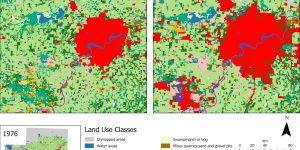
The city of Edmonton, Alberta, Canada has experienced great land use changes between 1966 and 1976. To study the land use changes and the corresponding spatial patterns, Canadian Land Use Monitoring (CLUMP) datasets were downloaded from GeoGratis for 1966 and 1976 respectively. A total of 14 land use classes have been delineated for Edmonton in both years. To better identify land use changes, check out the swipe widget on this interactive map!

Over 35,399 ha increase in area of urban built-up including cities, towns, villages and small settlements has been observed during the period. The rapid urbanization is accompanied by degradation and fragmentation of surrounding natural and semi-natural ecosystems. The 181% increase of urban area is mainly comprised of cropland, pasture and woodland. The loss of cropland area due to the urban expansion may negatively impact local agricultural economy (Hansen, 1984). Additionally, forested areas including woodland, pasture, and swamp have decreased significantly. Forested areas can provide multiple ecosystem services and goods such as carbon storage, climate change mitigation, and water purification. By dividing forested areas into small pieces, fragmentation reduces habitat continuity and significantly threats biodiversity and ecosystem services. However, there is an increase in urban green infrastructure including outdoor recreation area and horticultural are for vegetable and small fruit cultivation. Various benefits of these urban green spaces have been demonstrated incuding filtering air, attenuating noise, and regulating microclimate (van den Bosch and Nieuwenhuijsen, 2017). There is also evidence that increased access to greenness can be linked to higher frequency of physical activities and improved physical and mental health (van den Bosch and Nieuwenhuijsen, 2017).

Reference
Hansen, J. (1984). Canadian small settlements and the uptake of agricultural land, 1966-1976. Social Indicators Research, 15 (1): 61-84.
van den Bosch, M., & Nieuwenhuijsen, M. (2017). No time to lose—Green the cities now. Environment International, 99, 343-350.
